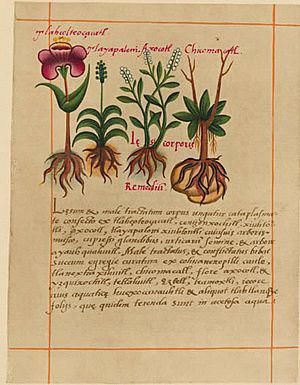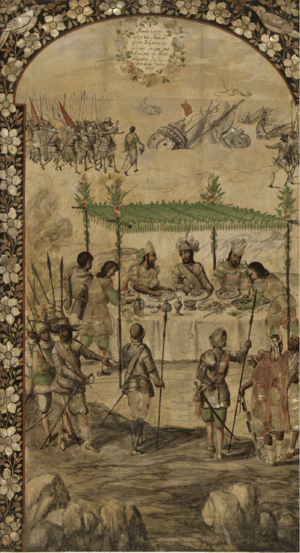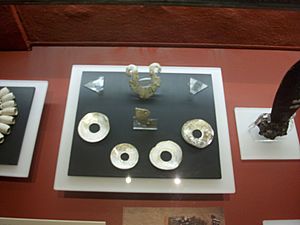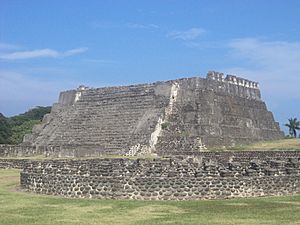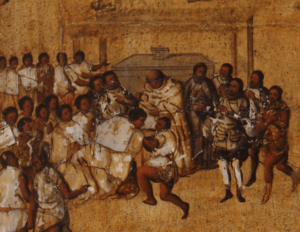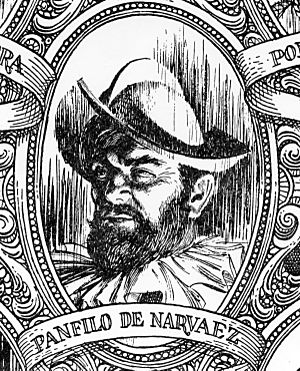Xicomecoatl facts for kids
|
Xicomecoatl
|
|
|---|---|
Quick facts for kids 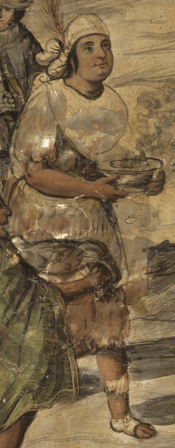
A painting of Xicomecoatl from 1698
|
|
| Nationality | Totonac |
| Other names | Chicomácatl |
| Occupation | Ruler of Cempoala |
| Era | Early 16th century |
Xicomecoatl, also known as Chicomácatl, was an important leader of the Totonac people. He ruled the city of Cempoala when it was part of the powerful Aztec Empire. The Spanish explorers, called conquistadors, sometimes called him "Cacique Gordo," which means "Fat Chief" in Spanish, because of his size.
Xicomecoatl is famous for forming an alliance with the Spanish captain Hernán Cortés on July 15, 1519. This made him one of the first local leaders to join forces with the Spaniards during their conquest of the Aztec Empire. Cempoala was a very important city, sometimes called "the capital of the Totonac empire," because it had a lot of influence over other Totonac towns.
Contents
Understanding Xicomecoatl's Name and Appearance
The Spanish writer Bernal Díaz del Castillo, who was with Cortés, often called Xicomecoatl the "Fat Cacique" in his book Historia verdadera de la conquista de la Nueva España. This was because Xicomecoatl was described as being very large. Another Spanish historian, Francisco López de Gómara, also noted that Xicomecoatl was taller and very strong, even though he was fat.
Historians usually call him Xicomecoatl, but it's not certain if that was his real name. Another name used for him is Chicomácatl. The name Chicomácatl might come from a plant used for medicine, which is described in an old book called Libellus de Medicinalibus Indorum Herbis.
Forming an Alliance with Spain
Before the Spanish arrived, the city of Cempoala had to pay large amounts of goods, called tributes, to Moctezuma II, the powerful ruler of the Aztec Empire in Tenochtitlan. Cortés wrote to the King of Spain, Carlos I, saying that the people of Cempoala were forced to be subjects of Moctezuma.
Meeting Hernán Cortés
Xicomecoatl first met Cortés on July 15, 1519. When he heard about the strange foreign men arriving by sea, Xicomecoatl sent 12 messengers to welcome them to Cempoala. The messengers explained that they wanted to make sure no Aztec soldiers would enter, as they caused a lot of trouble.
The next day, Cortés and his men went to Cempoala, guided by the messengers. This was the first time the Spaniards entered a major city within the Aztec Empire's influence.
When they arrived, the Spaniards were amazed by Cempoala's size and how busy it was. They had not seen such a large city before. Some Spaniards even compared it to the city of Seville in Spain.
Xicomecoatl and Cortés met in the main square of Cempoala. They hugged as a sign of friendship. Xicomecoatl offered the Spaniards a large place to stay and provided them with food like cornbread and fruits. They also exchanged gifts, including jewelry, clothes, and gold. Cortés, with the help of his translators Doña Marina and Gerónimo de Aguilar, promised to help Xicomecoatl and his people. He said they were sent by a great king to solve problems and stop harmful practices.
Xicomecoatl then complained about Moctezuma, saying that his people used to live peacefully before being forced to pay tributes. He claimed Moctezuma took most of their gold and jewelry, and they were afraid to resist. Cortés said he understood and would help them. Xicomecoatl also told Cortés about Moctezuma's allies and enemies, suggesting that Cortés could form alliances with groups like the Republic of Tlaxcallan to challenge the Aztec Empire.
This meeting was a key moment in the conquest of the Aztec Empire. Xicomecoatl saw the alliance as a chance to free Cempoala from Aztec control.
Strengthening the Alliance
Xicomecoatl was very friendly to the Spaniards. The day after their meeting, he gave them 400 workers, called tlamemehs, to help them with tasks.
Cortés then traveled to the city of Quiahuiztlan. Xicomecoatl followed him there with many people from Cempoala. In Quiahuiztlan, Xicomecoatl continued to complain about Moctezuma, and the leaders of Quiahuiztlan joined in. They claimed Moctezuma demanded children and young women as tribute and that his collectors sometimes mistreated their women. Cortés promised to protect them.
While they were talking, news arrived that Moctezuma's tribute collectors were in Quiahuiztlan. The local leaders became very scared. The collectors threatened Xicomecoatl and the others, demanding 20 people to be sacrificed as punishment for letting the Spaniards in. Cortés, understanding the situation, decided to act.
To show his loyalty to the Totonacs, Cortés ordered the arrest of the tribute collectors. Xicomecoatl was worried this would anger Moctezuma, but Cortés convinced him. All five collectors were arrested. Cortés then told the people of Cempoala, Quiahuiztlan, and other Totonac cities to stop paying tributes to Moctezuma and to rebel against him.
However, Cortés had a secret plan. That night, he secretly released two of the prisoners. He told them to go back to Tenochtitlan and tell Moctezuma that the Spaniards were not enemies but wanted to be allies. The next day, Xicomecoatl noticed two prisoners were missing and was upset, but Cortés pretended to be angry too. He then suggested sending the remaining prisoners to the Spanish ships, claiming they didn't deserve to be killed. These prisoners also disappeared the next day.
News of the arrests spread, and many Totonacs began to see the Spaniards as powerful. This event started a large alliance between the Spanish and over 30 Totonac towns against Moctezuma.
Rising Tensions
The Tizapancinca Situation
Soon after the arrests, Xicomecoatl asked Cortés for help with a nearby town called Tizapancinca. He claimed it was a dangerous town with Aztec soldiers who were causing problems for Cempoala. Cortés was unsure at first but decided to help.
Cortés used a soldier named Heredia to show the Totonacs the power of European weapons. He took Xicomecoatl and other leaders to a river and fired an arquebus (an early type of gun) into the air. The Totonac leaders were amazed and believed the Spaniards could defeat any enemy.
Cortés then marched to Tizapancinca with 400 Spaniards and about 2,000 Totonac soldiers. When they arrived, they found the town's people crying and begging for mercy. They explained that Xicomecoatl might have sent the Spaniards because of old conflicts between Cempoala and Tizapancinca. Cortés realized he had been misled. He stopped his Totonac allies from attacking and ordered them to return any stolen goods. Cortés apologized to the people of Tizapancinca and then returned to Cempoala. Xicomecoatl apologized for the misunderstanding, and Cortés accepted.
After this, Cortés sent a tribute to the King of Spain, including gold, pearls, clothes, and feathered headdresses. The next day, Cortés ordered his own ships to be destroyed. This meant his men had no way to return to Cuba, forcing them to continue their mission to Tenochtitlan.
Religious Differences and Temple Actions
Spanish chroniclers noted that human sacrifices were common in Cempoala. The Spaniards were horrified by these practices, and Cortés wanted to stop them.
When Cortés returned to Cempoala, the city's leaders asked the Spaniards not to leave, fearing Moctezuma's revenge. To strengthen their bond, Cortés suggested that Spanish captains marry noblewomen from Cempoala. Xicomecoatl offered eight women, including his niece, Doña Catalina, and his nephew's daughter, Doña Francisca.
Cortés accepted the women but said that for the alliance to be a true brotherhood, the Totonacs had to convert to Christianity, stop human sacrifices, and stop worshipping their traditional gods. The Totonacs refused, saying their gods brought happiness and well-being, and stopping their worship would cause disaster.
Despite their refusal, the Spaniards decided to destroy the representations of the Aztec gods. Xicomecoatl sent his soldiers to protect the temples. Cortés gave an ultimatum: the idols must be destroyed. Xicomecoatl tried to convince Cortés to stop, but Cortés insisted. He threatened to kill any soldiers who stood in the way. The Totonac soldiers, tired of the threats, allowed the Spaniards to proceed, but without their consent. The Spaniards then rushed into the temple and began destroying statues, throwing them down the stairs. Many Totonacs and priests cried and prayed.
Some Totonac soldiers prepared to fight the Spaniards. Cortés immediately went to Xicomecoatl and threatened to kill him if he didn't order his soldiers to stop. Xicomecoatl quickly ordered his soldiers to stand down. After this, Cortés worked to restore peace.
Peace and Departure
The next morning, Cortés ordered the broken statues to be burned and buried. He declared that Cempoala and Spain were now officially allied. He ordered a statue of Mary, mother of Jesus, to be placed in the main temple, the temple cleaned, and a wooden cross built in the main square. The temple was converted into a Catholic church. The next day, a Mass was held, and the eight women offered by Xicomecoatl were baptized and given to the Spanish captains.
A few days later, Cortés left Cempoala for Tenochtitlan. He asked Xicomecoatl to take care of the new church and cross. He also asked for 200 workers and 50 captains to help him on his journey. Xicomecoatl suggested that Cortés make an alliance with Tlaxcallan, an enemy of the Aztecs. Cortés followed this advice and left in August 1519. The women offered to the Spaniards stayed in Cempoala for their safety. Cortés continued to send gifts to Xicomecoatl.
When the Spaniards arrived in Tlaxcallan, they were initially attacked. However, by September 23, 1519, the Spaniards and Tlaxcalans made peace. The Tlaxcalan lords offered gifts and their daughters to the Spaniards, who were then baptized. Cortés stayed in Tlaxcala for 20 days. During this time, he sent messengers to Xicomecoatl, asking for clothes and food to be sent to Tlaxcala to strengthen the new alliance. Xicomecoatl agreed and traveled to Tlaxcala himself with the gifts and 200 workers.
Aztec Attacks and Spanish Response
The Aztec Empire repeatedly threatened Cempoala and other Totonac towns for their rebellion. Xicomecoatl often worried, but Cortés always promised protection.
On November 8, 1519, Cortés arrived in Tenochtitlan with soldiers from Cempoala and Tlaxcallan. He met Moctezuma II, who welcomed him with a grand ceremony. However, just six days later, Cortés ordered Moctezuma to be imprisoned. Cortés claimed this was because of an attack on Spanish and Totonac men in the province of Nautla.
A Spanish captain named Juan de Escalante, who was in charge of Veracruz, had been killed by an Aztec general, Qualpopoca, along with several men. This attack happened because Qualpopoca demanded tribute from the Totonacs of Tuxpan, who refused, saying Cortés had told them not to pay. Escalante tried to resolve the issue peacefully, but Qualpopoca challenged him to battle.
Escalante fought with a small force of Spaniards and Totonacs. Most of the Totonac soldiers ran away, leaving the Spaniards outnumbered. Escalante was fatally wounded, and one of his soldiers was captured and sacrificed. Escalante and six other wounded Spaniards died shortly after returning to Veracruz.
When Xicomecoatl heard about this defeat, he became very worried. This was the first time the Spaniards had been weakened by the Aztecs. He decided to prevent Spaniards from entering Cempoala until the issue with the tribute collectors was resolved. Cortés learned about this and used the incident as a reason to imprison Moctezuma.
Moctezuma claimed he knew nothing about the attack and allowed Cortés to capture Qualpopoca. About 20 days later, Qualpopoca was captured and executed. He confessed that Moctezuma was innocent and had not ordered the attack. Despite this, Moctezuma remained imprisoned.
The Battle of Cempoala
| Battle of Cempoala | |||||||
|---|---|---|---|---|---|---|---|
| Part of the Spanish conquest of the Aztec Empire | |||||||
 Area of Cempoala where the battle took place |
|||||||
|
|||||||
| Belligerents | |||||||
| Commanders and leaders | |||||||
| Strength | |||||||
| 266 Spaniards 200 Chinantec warriors |
Between 550 and 750 Spanish:
|
||||||
| Casualties and losses | |||||||
| 4 Spaniards killed Many Spaniards wounded Indigenous losses unknown |
5 killed Many wounded |
||||||
Xicomecoatl did not know that Cortés was also having trouble with the governor of Cuba, Diego Velázquez de Cuéllar. The governor had sent another Spanish captain, Pánfilo de Narváez, to arrest Cortés. Narváez arrived in Mexico in April 1520 with a much larger force of Spanish soldiers, artillery, and horses. He set up camp in Cempoala.
Narváez tried to convince people that Cortés was a liar and a criminal. He even sent messages to Moctezuma, claiming Cortés planned to kill him. Many people began to doubt Cortés, especially since Narváez was also Spanish. However, Xicomecoatl remained loyal to Cortés, believing he would not betray his allies.
According to reports, Narváez's men sacked the court in Cempoala, stealing gifts and taking noblewomen who had been offered to Cortés's men. Xicomecoatl tried to stop him, warning that Cortés would be angry. Narváez ignored him.
Cortés, still in Tenochtitlan, heard about Narváez's arrival in Cempoala. He decided to return to Cempoala to defeat Narváez, leaving his troops in Tenochtitlan under the command of Pedro de Alvarado.
The battle began on the night of May 27, 1520. Cortés had a much smaller force: only 266 Spaniards and 200 native allies. Narváez's troops failed to notice Cortés approaching due to heavy rain. When they finally did, Narváez ordered cannons to fire, but only a few shots were fired, killing a few of Cortés's men.
Cortés's captain, Gonzalo de Sandoval, led a group of men to capture Narváez, who was in one of the city's temples. This was a difficult task due to the temple's height and defenses. Narváez had been warned about Cortés's arrival but didn't believe he would actually fight.
Sandoval successfully reached the temple where Narváez was. The battle ended when some of Narváez's important soldiers were killed, and Narváez himself was stabbed in the eye by one of Cortés's soldiers, Pedro Sánchez Farfán, leaving him badly wounded. Narváez was captured soon after.
During the battle, Xicomecoatl was wounded by one of Narváez's soldiers while hiding in his palace. After the battle, Cortés ordered him to be taken to his room for treatment.
Narváez was held prisoner in Veracruz for two years before being sent back to Cuba. Cortés then convinced Narváez's remaining troops to join him and go to Tenochtitlan.
Although Cortés was outnumbered, he won the battle. However, it had unexpected consequences. While Cortés was away, Pedro de Alvarado ordered a massacre of civilians in Tenochtitlan, which led to the Battle of La Noche Triste on June 30, 1520. Also, one of Narváez's men had smallpox. During the battle, some of Cortés's men caught the disease and unknowingly carried it to Tenochtitlan, causing a terrible pandemic that killed millions of people.
Xicomecoatl's Role Later in the War
Xicomecoatl recovered from his wounds and continued to support Cortés. After the difficult battles of Noche Triste and Battle of Otumba, Xicomecoatl sent more soldiers and supplies to help Cortés. His alliance was very important throughout the war. It helped Cortés learn more about the land and find other allies against the Aztec Empire. Xicomecoatl also provided many soldiers who protected Cortés during his battles. What happened to Xicomecoatl after the conquest, or when he died, is not known.
See also
 In Spanish: Xicomecóatl para niños
In Spanish: Xicomecóatl para niños


